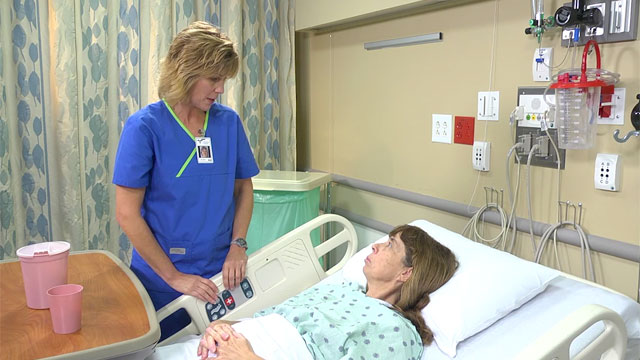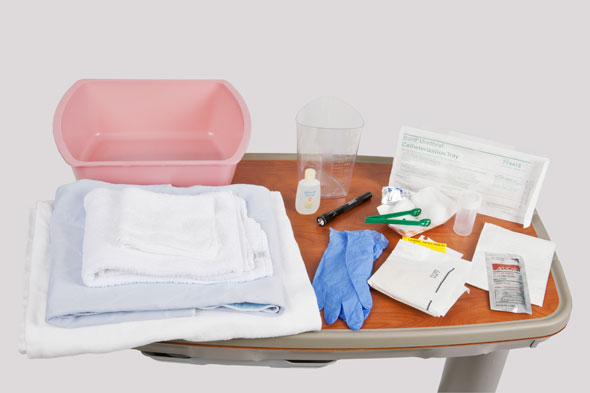Urinary Catheter Management
Select a Skill:
- » Inserting an Indwelling Urinary Catheter in a Female Patient
- » Inserting an Indwelling Urinary Catheter in a Male Patient
- » Irrigating a Urinary Catheter
- » Performing Intermittent Straight Catheterization
- » Obtaining a Specimen from an Indwelling Urinary Catheter
- » Removing an Indwelling Urinary Catheter
- » Caring for a Suprapubic Catheter
Take the Review Test:

Safety
- Implement actions to prevent catheter-associated urinary tract infection (CAUTI), including the following:
- Maintain aseptic technique when catheterizing a patient.
- Use the smallest catheter possible.
- Do not apply antiseptics to the urinary meatus; they are not effective.
- Use a nonlatex catheter if the patient is allergic to latex. Assess the patient for an allergy to the antiseptic and lubricant.
- Use a catheter of appropriate size, based on the patient’s health condition, since larger catheter diameters increase the risk for urethral trauma.
- Be aware that if no urine appears when catheterizing a female patient, the catheter may be in the vagina. If this occurs, leave the catheter in the vagina as a landmark indicating where not to insert, and introduce a new sterile catheter.
- In a male patient, if you feel resistance or he reports pain as the catheter is advanced, DO NOT USE FORCE. Stop advancing the catheter. Ask the patient to take slow, deep breaths to promote relaxation. Hold the catheter gently in place without forcing it. After a few seconds, the sphincter may relax and the catheter can be advanced. If you are unable to advance the catheter, the patient may have an enlarged prostate or another urethral obstruction.
Equipment
(Roll cursor over items to see labels)

Collection chamber (base of kit)
Single-lumen catheter
Antiseptic cleansing solution (or antiseptic-filled swabs)
Cotton balls
Fenestrated drape
Sterile forceps
Sterile gloves
Lubricant
Specimen container
Clean gloves
Waterpoof pad
Bath blanket
Penlight
Basin
Soap
Washcloth and towel
Graduated cylinder
Delegation
The skill of inserting a straight urinary catheter cannot be delegated to nursing assistive personnel (NAP). You may, however, direct NAP to do the following:
- Assist with patient positioning, focus lighting for the procedure, maintain privacy, empty urine from the collection container, and assist with perineal care.
- Report to you if the patient has a fever or complains of any discomfort after the procedure.
Preparation
- Review the patient’s medical record, including the health care provider’s order. Note any previous catheterizations, including catheter size, patient’s response, and time of catheterization.
- Review the medical record for any pathological condition that may impair passage of the catheter, such as an enlarged prostate gland in men or urethral strictures.
- Ask the patient and check the patient’s medical record for any allergies.
- Assess the patient’s weight, level of consciousness, developmental level, ability to cooperate, and mobility.
- Note the patient’s gender and age.
- Assess the patient’s knowledge, prior experience with catheterization, and feelings about the procedure.
- Assess for pain and bladder fullness. Palpate the bladder over the symphysis pubis, or use a bladder scanner (if available).
- Perform hand hygiene, and apply gloves. Inspect the perineal region, observing for perineal anatomical landmarks, erythema, drainage or discharge, and odor. Remove your gloves, and perform hand hygiene.
- Explain the procedure to the patient.
- Arrange for extra personnel to assist you as necessary.
Follow-up
- Palpate the patient’s bladder for distention, or use a bladder scan.
- Ask the patient to describe his or her level of comfort.
- Monitor for postvoid care based on orders and policy.
Documentation
- Record and report the reason for straight catheterization; type and size of straight catheter used; characteristics of the urine and amount produced; patient’s response to the procedure; and date, time, and patient education provided.
- Record the amount of urine.
- If the patient has any catheter-related pain or discomfort, report it to the health care provider.
Review Questions
1. While performing an intermittent straight urinary catheterization of a female patient, the nurse inadvertently inserts the catheter into the patient’s vagina. Which action would the nurse take next?
 Remove the catheter, and rinse it thoroughly in sterile water for reuse.
Remove the catheter, and rinse it thoroughly in sterile water for reuse. Keep the catheter in place, and begin again with a new sterile catheter.
Keep the catheter in place, and begin again with a new sterile catheter. Remove the catheter, relubricate it, and insert it into the urinary meatus.
Remove the catheter, relubricate it, and insert it into the urinary meatus.  Stop advancing the catheter, and notify the health care provider.
Stop advancing the catheter, and notify the health care provider.
2. While attempting to perform a straight catheterization for a male patient, the nurse advances the catheter 3 to 4 inches into the meatus but observes no urine flow. Which action would the nurse take at this time?
 Continue to advance the catheter until 5 to 7 inches of the catheter tube has been introduced into the urethra.
Continue to advance the catheter until 5 to 7 inches of the catheter tube has been introduced into the urethra. Withdraw the catheter to 1 inch, and ask the patient to cough.
Withdraw the catheter to 1 inch, and ask the patient to cough. Encourage the patient to cough as the catheter is advanced.
Encourage the patient to cough as the catheter is advanced. Apply pressure to the patient’s lower abdomen over the bladder.
Apply pressure to the patient’s lower abdomen over the bladder.
3. The nurse instructs nursing assistive personnel (NAP) regarding proper technique for intermittent straight catheterization of a male patient. Which statement made by NAP indicates that the instruction was effective?
 “I’ll help you set up the sterile field.”
“I’ll help you set up the sterile field.”  “I’ll get a sterile urine cup for you.”
“I’ll get a sterile urine cup for you.”  “There are leg straps in the utility room.”
“There are leg straps in the utility room.”  “I’ll help keep his legs away from the sterile field.”
“I’ll help keep his legs away from the sterile field.”
4. Why does the nurse cleanse a female patient’s perineum before inserting an intermittent urinary catheter?
 To encourage the bladder to drain fully
To encourage the bladder to drain fully  To encourage spontaneous voiding
To encourage spontaneous voiding  To prevent bowel elimination during the procedure
To prevent bowel elimination during the procedure  To reduce the patient’s risk of urinary tract infection
To reduce the patient’s risk of urinary tract infection
5. The nurse has completed an intermittent straight urinary catheterization of a female patient. Which action would the nurse delegate to nursing assistive personnel (NAP)?
 Measure and empty the urine.
Measure and empty the urine.  Palpate the abdomen.
Palpate the abdomen.  Ask the patient if she has any pain.
Ask the patient if she has any pain.  Document the procedure.
Document the procedure.
You have completed the Review Questions for this skill. To take the Review again select the Start Over button. To proceed to another skill select from the dropdown menu. Select the Home or Back button to proceed to the next section.


